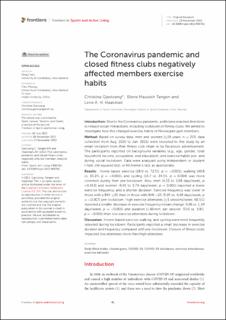The Coronavirus pandemic and closed fitness clubs negatively affected members exercise habits
| dc.contributor.author | Gjestvang, Christina | |
| dc.contributor.author | Tangen, Elene Mauseth | |
| dc.contributor.author | Haakstad, Lene Annette Hagen | |
| dc.date.accessioned | 2023-03-02T12:21:11Z | |
| dc.date.available | 2023-03-02T12:21:11Z | |
| dc.date.created | 2022-11-23T08:52:47Z | |
| dc.date.issued | 2022 | |
| dc.identifier.citation | Frontiers in Sports and Active Living. 2022, 4, Artikkel 985782. | en_US |
| dc.identifier.issn | 2624-9367 | |
| dc.identifier.uri | https://hdl.handle.net/11250/3055365 | |
| dc.description | This is an open-access article distributed under the terms of the Creative Commons Attribution License (CC BY). The use, distribution or reproduction in other forums is permitted, provided the original author(s) and the copyright owner(s) are credited and that the original publication in this journal is cited, in accordance with accepted academic practice. No use, distribution or reproduction is permitted which does not comply with these terms. | en_US |
| dc.description.abstract | Introduction: Due to the Coronavirus pandemic, politicians enacted directions to reduce social interactions, including lockdown of fitness clubs. We aimed to investigate how this changed exercise habits of Norwegian gym members. Method: Based on survey data, men and women (≥18 years, n = 233, data collection from Aug. 2020 to Jan. 2021) were recruited to this study by an email-invitation from their fitness club chain or by Facebook advertisement. The participants reported on background variables (e.g., age, gender, total household income, occupation, and education), and exercise habits pre- and during social lockdown. Data were analyzed using independent or student t-test, chi-squared test, or McNemar's test, as appropriate. Results: Home-based exercise (18.0 vs. 72.5%, p = <0.001), walking (49.8 vs. 65.2%, p = <0.001), and cycling (16.7 vs. 24.5%, p = 0.004) was more common during than pre-lockdown. Also, men (4.33 to 3.68 days/week, p =0.013) and women (4.20 to 3.79 days/week, p = 0.001) reported a lower exercise frequency, and a shorter duration. Exercise frequency was lower in those with a BMI ≥25 than in those with BMI <25 (3.95 vs. 4.48 days/week, p = <0.007) pre-lockdown. High exercise attendees (≥3 sessions/week, 66.5%) reported a smaller decrease in exercise frequency (mean change: 0.06 vs. 1.24 days/week, p = <0.001) and duration (>60 min. per session: 33.0 vs. 3.8%, p = <0.001) than low exercise attendees during lockdown. Discussion: Home-based exercise, walking, and cycling were most frequently reported during lockdown. Participants reported a small decrease in exercise duration and frequency compared with pre-lockdown. Closure of fitness clubs impacted low attendees more than high attendees. | en_US |
| dc.language.iso | eng | en_US |
| dc.subject | Body Mass Index | en_US |
| dc.subject | closed gyms | en_US |
| dc.subject | COVID-19 | en_US |
| dc.subject | COVID-19 lockdown | en_US |
| dc.subject | exercise attendance | en_US |
| dc.subject | exercise behavior | en_US |
| dc.title | The Coronavirus pandemic and closed fitness clubs negatively affected members exercise habits | en_US |
| dc.type | Peer reviewed | en_US |
| dc.type | Journal article | en_US |
| dc.description.version | publishedVersion | en_US |
| dc.rights.holder | © 2022 Gjestvang, Tangen and Haakstad | en_US |
| dc.source.pagenumber | 12 | en_US |
| dc.source.volume | 4 | en_US |
| dc.source.journal | Frontiers in Sports and Active Living | en_US |
| dc.identifier.doi | 10.3389/fspor.2022.985782 | |
| dc.identifier.cristin | 2078820 | |
| dc.description.localcode | Institutt for idrettsmedisinske fag / Department of Sports Medicine | en_US |
| dc.source.articlenumber | 985782 | en_US |
| cristin.ispublished | true | |
| cristin.fulltext | original | |
| cristin.qualitycode | 1 |
Tilhørende fil(er)
Denne innførselen finnes i følgende samling(er)
-
Artikler / Articles [2097]
-
Publikasjoner fra Cristin [1085]
